Airblade Preview
We take a long look at Criterion's upcoming hoverboarder, Airblade.
Criterion Studios is a UK-based developer with a pretty impressive lineage. Its parent company, Criterion Software, is a subsidiary of Canon and the force behind the Renderware middleware package, which forms the foundation of a great many high-profile games--Ubi Soft's Rayman Revolution and Midway's upcoming Mortal Kombat 5, among others. The studio has worked on games with regularity for several years, all of which have been immensely impressive, from a technological standpoint. Its latest project, titled Airblade, is proof that the studio has considerable design chops as well. The game revolves around the enticing concept of a gravitationally liberated skateboard and is a loose follow-up to Trickstyle--that well-intentioned Dreamcast launch title. Its form, however, bears a much closer resemblance to modern boarding titles than it does to its "predecessor." Recently, we convinced Criterion's creative director Paul Glancey to talk about the game at considerable length. He was happy to clarify the game's relation to its lineage: "The only thing Airblade shares with Trickstyle is the fact that the player rides on a floating board. Aside from that, they're very different games. Trickstyle was primarily a racing game, and Airblade's gameplay is much more mission- and trick-based, and it's set in a much more contemporary (not futuristic) world."

The game was compelling at first sight, and anyone present at this year's E3 will attest to the level of polish that Airblade exhibited on display. Not to downplay the technical achievements of its predecessor, but Airblade easily seemed leagues above Trickstyle in almost every conceivable respect. "Obviously, there is a whole load of technical improvements, because our engineers and designers are a bit more experienced since they finished Trickstyle back in 1999. But the most notable improvement, I think, aside from just having better graphics, sound, gameplay depth, etc., is that we've gone to great efforts to make the game easy to pick up and play, so players can have fun, look cool, and get spectacular rewards very quickly. A lot of players found Trickstyle frustratingly difficult when they first started playing, and that counts heavily against the game," Glancey told us. Clearly, a whole lot of thought and time went into the development of Airblade--resources that few studios have easy access to. Luckily for Criterion, it seems to be well positioned enough to have ready supplies of both.
The game tells the story of Ethan, a hotshot skater, whose friend Oscar worked at a certain GCP Corporation. Oscar happened to invent a hoverboard while simultaneously working on a secret project for the GCP Corporation. During the course of his research, Oscar found a way of generating unlimited energy via force field technology. Upon learning the results of his research, the GCP Corporation feared a loss in profits, because the new discovery would threaten to collapse the oil market. The decision was made to fire Oscar, but the corporation wasn't able to enact its will: Oscar managed to escape the building with his prototype hoverboard before the company's security got a hold of him. Nevertheless, he was soon found and subsequently whisked away, to whereabouts unknown. Ultimately, it's up to Ethan--who managed to hold on to the hoverboard, called "Airblade"--and his friends to find Oscar and free him from the corporation. In particular, a crackpot computer specialist named Kat provides Ethan with much help in his quest to find Oscar. Clearly, one of Airblade's most distinct properties is its story--or, more specifically, the fact that it focuses pretty heavily on it.
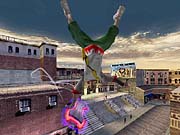
"Lots of people ask this, and yes, it is unusual, and we've taken a few risks to do it. The obvious answer is that it clearly differentiates Airblade from competing products. In addition, though, we did think that if you gave people this amazing piece of kit and stuck them in a regular skate-game location like a schoolyard or a shopping mall or whatever and said, "Off you go and do some tricks!" that would have been pretty crappy. This Airblade is an absolutely awesome piece of gear! It's an antigravity skateboard! So it's bound to be the cause of some greater excitement in the gameworld. We really wanted to make it and the characters surrounding it the stars of the show, so we created this story. That said, we didn't really want the story to be massively overblown and intrusive. We just wanted it to provide the background to some really excellent and extraordinary trick-based action that's more exciting than you'd find in any other game," said Glancey. The trick, of course, is to wrap these elements around an engaging game design in a nonintrusive way.
Scope
Airblade's single-player game focuses on its story mode, which is where you're sent on the quest to find Oscar. Its missions--six in all--have you fulfilling certain tasks in every level, much like a mission-based driving game would. In the first level, for instance, you have to knock out guards, destroy a GCP limousine, and the like. Later missions have you smashing billboards, taking out surveillance cameras (by grabbing them and spinning them around until they break), and eliminating floodlight-equipped patrol cars. Regardless of your objectives, an arrow always leads you to your next target, though the way isn't always direct; the vast areas are littered with rails that lead to rooftops, stairs, and numerous crossroads. Areas like parking lots or ramps, moreover, offer plenty of possibilities to jump on higher platforms, making the environments quite organic. Sometimes, you'll actually have to stop Ethan (by pressing L2) just to get a grip on the many paths available to reach a certain street or rooftop. Since you constantly hover and accelerate when you don't press a button, stopping Ethan is the only possibility to have a break and look around. But a threateningly quick time limit looms at all times, making stopping often unwise. If you haven't completed all mission objectives within the time frame, you have to restart the level.

Most missions consist of around four sub-objectives, which isn't as overwhelming as the lengthy lists in the Tony Hawk series. In Airblade, rather, you're presented with things to do bit by bit. Once you've successfully completed a mission, you can proceed to the next level, which is introduced by an in-game cutscene that reveals more about the progress of the search for Oscar. A host of auxiliary modes complement the meat of the game. Glancey explains: "We have a score attack mode, which is about scoring as many trick points as possible in a time limit. We have a freestyle mode, so you can explore and practice levels as they're opened up. We also have a training mode set in its own level. And finally, we have the stunt attack mode, which is like an extended remix of the story mode that is unlocked when the story mode is completed. This comprises a completely different set of missions which have more to do with demonstrating the skills you should've picked up during the rest of the game, so you have to perform grinds and combos of certain sizes to succeed and explore areas of the level of which you previously thought, 'I wonder what's up there?' but never got the chance to look."
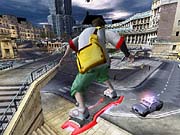
The multiplayer modes are equally diverse. While the score attack and trick list are very straightforward, the show-off mode is very much whimsical. In it, two players perform tricks via split screen on any of the unlocked levels. There is a color-coded display onscreen that keeps track of who's on top in the categories of air, combos, and grinds. Players with the most categories in their favor win. The ribbon tag mode that was displayed at E3 is equally challenging: You have to find a ribbon that's hidden somewhere in the environment, which, when acquired, gradually lengthens. If another player catches the ribbon, he will carry it until the other player steals it again. The one who scores the most steals wins. And last but not least, there's the party mode, which allows for up to eight players. It's a knockout system, basically, wherein each player performs tricks in a level for one minute. The player with the fewest points is eliminated after each round, while the others proceed to the next level until only one player is left--the winner.
Movement and ether
Airblade's controls are as tight as can be expected given that you're controlling a hoverboard. As long as you don't expect it to have the grip of a skateboard, you'll be fine. Many times, you'll find yourself circling around an intended target because you're constantly on the go. Once you've gathered an overview of a level, though, you'll feel right at home. The X button lets you jump, the square button executes your tricks, and the O button lets you perform all kinds of grabs--poles, streetlights, and even your hoverboard are fair game during a jump. The triangle button, finally, lets you grind cars, banks, ceilings, or rails, with the left analog stick controlling balance.
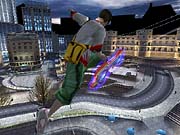
We find the trick system to be plenty deep. Glancey had this to say about it: "Each of the player characters (of which there are five...well, six if you count...Oops! I can't say!) has their own set of tricks, which numbers about 30 different moves. They include grab tricks, flip tricks, a variety of different grinds, and you can modify them all (even the grind) by spinning the Airblade while you're doing it. The fact that we have this antigravity skateboard gave us the opportunity to push the envelope a little bit further. So although most of the tricks are based on skate moves, a lot of them are rather more outrageous and spectacular than most players will be used to." Given the crazy dynamics of zero-G hotdogging, you can bet that there's quite a bit of spectacular stuff going on.
Visually, the game is quite impressive in its current state, due a great deal to the especially busy stages. Pedestrians are walking around, choppers are flying over the area, cars and vans are driving through the streets, objects are scattered throughout the levels, all of which gives you the feeling that there's always something going on. "The overall quality of the scenery, the details, NPCs, vehicles, the player-character animation, and even the general presentation are really extraordinary--real next-generation stuff you'd expect from the PlayStation 2. No fogging, no pop-up--you can stand at the top of one side of the world and see right across to the far wall, and these worlds are vast. Everyone who sees the game is struck by how great it looks. I'm really proud of all our artists," said Glancey, when asked about the game's visuals. Motion blurs, particle effects, and creative lighting all pepper the game, and it all truly adds a great deal of flair to the game's realistic environments.
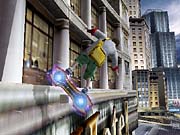
The game's stylistic vision, though, is quite grounded in reality. Aside from the fantastic device at your disposal, everything around you is quite a part of the 20th-century Western world. "We've tried to make the game look as realistic as possible because we didn't want to throw people off because the game was too sci-fi or too cartoony or so stylized you don't know what it is. Somebody seems to be putting it about that the game is set in 2015 or something, but it's not meant to be. If you look at all of the settings and the characters, they're all set in the here-and-now. The Airblade is the only thing that's strange and unusual," Glancey told us. Still, the action more than perpetuates the fantasy, making the hybrid line that the game rides even more exciting.
Airblade is not yet confirmed for a US release, but since the game was also shown at E3 in May, we're expecting an announcement for the American market sometime soon. Meanwhile, the game is still on track for a release in Europe at the end of this year. We'll have more concrete information for you very soon. We spoke to Glancey at great length, however, so turn the page and check out the information that our talk yielded.
Q&A with Paul Glancey
GameSpot: Will there be any character progression (such as learning new tricks, getting better stats) as you progress through the game?
Paul Glancey: There's character progression in that if you're skillful enough you can unlock the different player characters with their different moves as you play through story mode. Then you can use them in the other single- and multiplayer games. There's also an element of unlocking some other surprise treats if you get good at the game.
GS: What about online support?
PC: Hopefully with Sony's help we'll be looking very closely at online options in the future, but as there are a few technical issues involved with getting that right, we thought we'd cater to the current majority of players by making the game we had really great.

GS: How many polys will the characters be composed of? What about the elements in the environments?
PC: Characters, around 6,000 polys. Environments, it varies because the size of the levels vary from "big" to "huge."
GS: Care to talk about the tools you guys have used to develop the game?
PC: Criterion's Renderware toolkit gives us a head start because it takes care of all the tedious things you have to do at the start of a project like building a game engine. Some developers spend the first six months of their project getting something on the screen. When we started work on Airblade we had a playable demo of the game in six weeks. Like all developers who use Renderware, though, the Airblade engineers have built their own code and tools to deal with the specific needs of the game, but having that core technology to build upon has been a big help.
GS: Did the team encounter any problems or hurdles with the PS2 hardware?
PC: Well, I'm pleased to say we have an excellent team of software engineers here, and over the course of this project they've really come to grips with the hardware. It's not exactly a piece of cake to program a PS2 game, and the learning curve has been a little steep, but it's worth the effort because it's such a powerful beast of a machine.
Q&A with Paul Glancey
GS: Have the game's level designs greatly influenced the development of its story, or vice versa?
PC: One of the best things about the story from our point of view is that once we decided what it was going to be, it took us in directions that led to really exciting and extraordinary level designs and game features. However, we occasionally tried to steer the story back in directions that would lead the player through the sorts of locations that offered a lot of potential for amazing action, like the tops of skyscrapers. So a bit of both really. It's an organic process.
GS: Have you any plans for the future of the series?
PC: Well, after Airblade goes gold in a few weeks' time, we're all going to have a bit of a lie-down before we make any big plans for a sequel. Hey, if everybody who owns a PS2 buys it...
GS: Any word on the game's soundtrack? Will it be composed of original compositions or licensed songs?
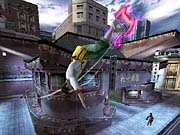
PC: Pretty much our entire audio team joined us when the project was just getting up to speed, and they've done a great job. Our music is largely the work of our head of audio, Stephen Root, who previously produced the awesome music for games like Die Hard Trilogy and Alien Trilogy. He's produced a style of music that's kind of between rock and hip-hop. The music in the story mode ramps up dynamically, so you generally start off with this easygoing bass line, then as you complete missions, new mixes are layered on top, so by the end of the level you've got high-adrenaline audio craziness going on in your ears.
GS: Do you have any final words for gamers out there interested in Airblade?
PC: Even if you've never played a skating or boarding game before, try Airblade and it'll convert you. If you have played skating and boarding games before, try Airblade and it'll take you to a new plane of urban trick-based excitement! It's out in the PAL territories (Europe, Australasia, etc.) in November, but keep an eye out for an announcement about a release date in the other territories soon.
Got a news tip or want to contact us directly? Email news@gamespot.com
Join the conversation